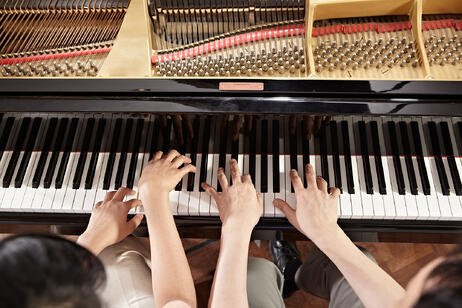Ear training is a facet of musical study often not addressed in private lessons. In higher education we are provided classes in ear training to supplement our studies of a particular instrument. Younger students, who may have one weekly lesson in music, wouldn’t get exposure to this approach in many cases. What is ear training then, and why is it beneficial to the beginner or the musician of a younger age?
Ear training is a pedagogical tool used to reinforce concepts that are learned in a more tactile and visual manner. When analyzing a score we initially see a lot of information written on the page. A teacher may point out that the melody moves from line to line in a particular measure and the student then will play that interval on his or her instrument. The student has then fortified the meaning of that interval in only two ways. Auditory meaning of the interval of a 3rd needs to be established as well.
I’ve experienced instances of a student reading a passage of music and following the direction of the phrase perfectly. Many of the notes would be incorrect however. Without a strong concept of what the notes should sound like it’s quite easy to get off course. Music is meant to be listened to after all, so developing a student’s ability to listen is crucial. Certainly in the midst of playing a piece it’s hard for a student to have all this in the forefront of his or her mind. Because of this I find it useful to methodically take only a few minutes of each, or every other lesson, to practice ear training.
There are a myriad of ways to practice ear training, most of which are very fun and excellent for changing the pace of a lesson. Often I’ve had a student ask me if we are going to play an “Ear Training Game” today. I’ll describe below a few ear training exercises that I’ve found useful for younger or beginner students.
the pace of a lesson. Often I’ve had a student ask me if we are going to play an “Ear Training Game” today. I’ll describe below a few ear training exercises that I’ve found useful for younger or beginner students.
“Unison” or “Not Unison”
Demonstrate a short passage, or one interval, where either the two voices are in unison or not and the student then answers. This is useful in showing that two pitches, perhaps “D” and another “D” an octave above, sound the same even though they are technically two different notes.
“Skip” or “Step” (2nd or 3rd)
This is a straightforward exercise for the teacher and student. This helps establish the concept of intervallic distance for the ears. Basic intervals are addressed in beginner method books (Line to space, Line to Line or Space to Space) pertaining to what they look like on the staff. This also helps giving the student a different perspective on that information.
Direction of Melody
Demonstrate a short melody. Either “up” or “down.” The student will then answer what direction the melody has traveled. This helps the student make the connection of what moving “higher” or “lower” on the instrument actually sounds like as well as what it looks like in the score.
Again, there are many more exercises capable of benefiting the student. It’s also very fun to create your own exercise, or ear training game! Ear Training is a broad topic worthy of much discussion and its application produces very “tangible” results!
Drew Spradlin, Piano Instructor at YOUniversity of Music and Arts


COMMENTS